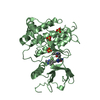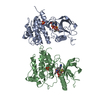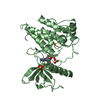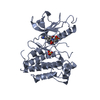Entry Database : PDB / ID : 8y22Title FGFR1 kinase domain with a covalent inhibitor 9g Fibroblast growth factor receptor 1 Keywords / Function / homology Function Domain/homology Component
/ / / / / / / / / / / / / / / / / / / / / / / / / / / / / / / / / / / / / / / / / / / / / / / / / / / / / / / / / / / / / / / / / / / / / / / / / / / / / / / / / / / / / / / / / / / / / / / / / / / / / / / / / / / / / / / / / / / / / / / / / / / / / / / / / / / / / / / / / / / / / / Biological species Homo sapiens (human)Method / / Resolution : 2.792 Å Authors Chen, X.J. / Chen, Y.H. Funding support Organization Grant number Country National Natural Science Foundation of China (NSFC) 82202920 National Natural Science Foundation of China (NSFC) 82172654
Journal : Eur.J.Med.Chem. / Year : 2024Title : Design, synthesis and biological evaluation of 5-amino-1H-pyrazole-4-carboxamide derivatives as pan-FGFR covalent inhibitors.Authors : Deng, W. / Chen, X. / Liang, H. / Song, X. / Xiang, S. / Guo, J. / Tu, Z. / Zhou, Y. / Chen, Y. / Lu, X. History Deposition Jan 25, 2024 Deposition site / Processing site Revision 1.0 Jun 26, 2024 Provider / Type Revision 1.1 Oct 30, 2024 Group / Category / pdbx_modification_feature / Item
Show all Show less
 Open data
Open data Basic information
Basic information Components
Components Keywords
Keywords Function and homology information
Function and homology information Homo sapiens (human)
Homo sapiens (human) X-RAY DIFFRACTION /
X-RAY DIFFRACTION /  MOLECULAR REPLACEMENT / Resolution: 2.792 Å
MOLECULAR REPLACEMENT / Resolution: 2.792 Å  Authors
Authors China, 2items
China, 2items  Citation
Citation Journal: Eur.J.Med.Chem. / Year: 2024
Journal: Eur.J.Med.Chem. / Year: 2024 Structure visualization
Structure visualization Molmil
Molmil Jmol/JSmol
Jmol/JSmol Downloads & links
Downloads & links Download
Download 8y22.cif.gz
8y22.cif.gz PDBx/mmCIF format
PDBx/mmCIF format pdb8y22.ent.gz
pdb8y22.ent.gz PDB format
PDB format 8y22.json.gz
8y22.json.gz PDBx/mmJSON format
PDBx/mmJSON format Other downloads
Other downloads 8y22_validation.pdf.gz
8y22_validation.pdf.gz wwPDB validaton report
wwPDB validaton report 8y22_full_validation.pdf.gz
8y22_full_validation.pdf.gz 8y22_validation.xml.gz
8y22_validation.xml.gz 8y22_validation.cif.gz
8y22_validation.cif.gz https://data.pdbj.org/pub/pdb/validation_reports/y2/8y22
https://data.pdbj.org/pub/pdb/validation_reports/y2/8y22 ftp://data.pdbj.org/pub/pdb/validation_reports/y2/8y22
ftp://data.pdbj.org/pub/pdb/validation_reports/y2/8y22

 F&H Search
F&H Search Links
Links Assembly
Assembly


 Components
Components Homo sapiens (human) / Gene: FGFR1, BFGFR, CEK, FGFBR, FLG, FLT2, HBGFR / Production host:
Homo sapiens (human) / Gene: FGFR1, BFGFR, CEK, FGFBR, FLG, FLT2, HBGFR / Production host: 
 X-RAY DIFFRACTION / Number of used crystals: 1
X-RAY DIFFRACTION / Number of used crystals: 1  Sample preparation
Sample preparation ROTATING ANODE / Type: Cu FINE FOCUS / Wavelength: 1.587 Å
ROTATING ANODE / Type: Cu FINE FOCUS / Wavelength: 1.587 Å Processing
Processing MOLECULAR REPLACEMENT
MOLECULAR REPLACEMENT Movie
Movie Controller
Controller



 PDBj
PDBj












